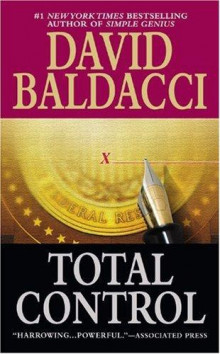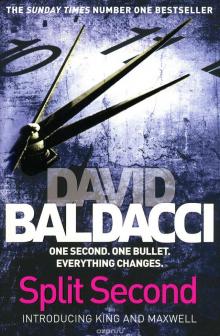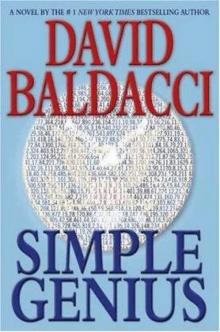- Home
- David Baldacci
Long Road to Mercy Page 8
Long Road to Mercy Read online
Page 8
She took off her sweatshirt, revealing the tank top underneath. This also showed off four tats Pine had. On one delt was the symbol for Gemini, the astrological mark of the twin. It was simply the Roman numeral two, which looked like the symbol for Pi, but with another line added at the bottom. On the other delt was the astrological symbol for the planet Mercury, which ruled the world of the Geminis. It was comprised of a cross on the bottom, a circle on top of the cross, and an upward crescent on top of the circle.
Along both of Pine’s long arms, starting at the forearms and working their way up toward each delt, were the words “No Mercy.”
Gemini, community, sisters. Pine had had the tats put on in college. During her weightlifting career, many had remarked on the images since they had been clearly visible while she competed. Pine had never answered any queries about them. The tats were for her and her sister, and no one else.
She warmed up and hit the weights with a ferocity that was clearly channeling the frustration she was feeling with her investigation.
Multiple sets of flat and then incline bench press, military and swimmer’s press, the squat rack, deadlift, calf raises, depth charges, push-ups on one leg, regular pull-ups and then round-the-world reps that had her take her chin from hand to hand, dips, pounding the core with medicine balls, pendulum lifts with a thirty-pound kettle ball, and then a forty-pound one. Then came isometrics that had the sweat pouring off her from standing in one spot, followed by endless deep lunges with the kettles being passed under each hammy, decline push-ups, crunches, sumo squats with ass-busting dumbbells, and then she jumped rope for ten minutes, doing crossovers every fifth rep.
Then it was time for the pièce de résistance. Everything else had simply been a warm-up. A rehearsal for the real show. She wanted to do it while she was tired, otherwise, what was the point?
She loaded the plates on a bar, chalked her hands, and bent over the bar.
Pine was tall for a female weightlifter. This was an advantage and a disadvantage. From simply a physics point of view, shorter people had shorter distances to heft the weight. And shorter muscles tended to be more explosive in nature, because of the very same rule of science. But Pine’s longer muscles gave her tremendous leverage that shorter muscles simply could not muster.
She closed her eyes and focused everything she had in a way that only a trained athlete needed to. The mind ready, she needed to execute what was called the “dynamic start.” This would separate the weights from the floor. With a sudden, explosive movement, Pine performed the clean part of the lift, curling the loaded bar under her chin while simultaneously nailing the squat perfectly. She then performed the bounce, rose up with the barbell, completing the concentric phase, and, with a whoosh of released air, jerked it cleanly overhead as she split her legs performing the drive position. Then, legs parallel, she held the weights steadily aloft.
Clean and jerk. Done.
There was a lot more to the Olympic lifts than people probably thought. It wasn’t merely about brute strength. Pine had seen enormous men, far stronger than she, fail to clean and jerk or snatch as much weight as she could. You needed to be strong, for sure, but your technique needed to be flawless. That was why terms like the bounce, the concentric, the double-knee bend or scoop, the drive, the dynamic start, and the second pull were all things that had been beaten into her mind and her muscle memory. You needed to do all these things at the exact right moment and with the requisite forward and upward momentum to have a chance of moving twin columns of massive plates stacked on a bar where you wanted them to go.
She dropped the barbell, stopping it with her hand as it bounced back up, and then the weights fell back to the floor and stayed there. It was a practiced motion, one she had done thousands of times before.
She unloaded some weights, spun on the collars, readied herself, measuring her breaths, squaring her feet, chalking her hands once more. For this one she put leather lifting straps on her wrists, because the torque on those joints was going to be a bitch. This ensured that her hands and the metal would not go their separate ways.
Okay, this is for the gold. Or at least a spot on the damn team. In my dreams.
She bent down, set the wraps, and gripped the barbell with her hands spread wide, nearly touching each inside plate. She got her mind straight, because it was just as much mental as physical. Maybe more mental. She imagined the burst of force and the precise movement required to take this weight from the floor to over her head in one nearly seamless motion. The bar would initially come up to about her waist for less than a beat, and then with a powerful flick, be cast over her head, her arms straight, her butt a few inches from the floor. It was not a natural movement, and it required immense core strength and concentration. There was no margin for error.
That was the essence of the snatch.
Whoever had devised this lift, Pine thought, was one sick bastard.
This lift was, and always had been, her nemesis, her Waterloo, the reason she had not gone to the Athens Olympics in ’04. Athens, where it had all started, way back in 1896. How special would that have been? Well, she’d never found out.
Pine steadied her breathing, going longer and longer on the inhales and exhales. She was building up to the exact right timing of her last inhalation and exhalation where the snatch phase would come. It was all timing, technique, and a level of explosive strength most people couldn’t comprehend, male or female.
She performed the first part flawlessly, squatting there with her arms in the shape of a V and the weight directly above her head, her butt nearly touching the rubberized floor. Her pull, power, scoop, and second pull execution had been one of her best ever.
Only she wasn’t done.
Okay, Atlee, this is for the money. Just stand up. Couldn’t be simpler. Just stand up. One . . . two . . . three . . .
But when she tried to rise, things started to unravel—a tremble of thigh, a twitch of hamstring, the slightest giving way of her left triceps—and she had to drop the bar, falling back on her ass in the process.
She sat there, breathing hard, the sweat dripping down her face and onto her chest, her gaze pointed at the floor.
Defeated.
Six-pack and Knee Rehab had long since gone.
But Kenny Kuni was still there.
“You good?” he called out in a casual tone as he did some paperwork at the front counter.
She nodded and gave him a thumbs-up.
Not the first time this had happened.
He went back to his paperwork.
“Shit,” she muttered. She was not good. Despite her excellence in the first half of the lift, her form had sucked in the final stage, which was all that mattered. Her mental mechanics had completely broken down. She had been intimidated. Afraid.
Shit.
She finally rose and performed the Yoga and Pilates regimen that constituted her cooldown. Her muscles felt good stretching out, the tendons, ligaments, and cartilage all thanking her for the relief after the merciless pounding of iron.
She hit the shower, changed into her work clothes, and walked out, hair still wet.
This had been her time. Now the FBI owned her for the rest of the day.
CHAPTER
13
Pine drove to her office and entered the underground parking garage. There was a guy on duty there, and after hours the overhead door would come down, requiring key card access.
This level of security was not because of Pine’s presence.
It was because of the other law enforcement agency located here.
ICE. Immigration and Customs Enforcement.
Today, it was more known for immigration enforcement. And they were very active in Arizona, rounding up and deporting masses of people. It had become a political football, really.
Because of that there had been threats made. And the building might be a target. Hence the security guy and the overhead door with key card access.
Pine routinely saw some of the ICE g
uys in and around the building. She knew all the agents there, but didn’t really hang with them very often, because they kept to themselves. She was FBI, under the Justice Department. ICE was under the Department of Homeland Security. There was a bit of a federal rivalry there, but their work almost never overlapped. But they were fellow feds and she would always have their backs if they needed it.
The underground garage kept the sun off the cars during the day. It was actually a necessity here, especially during the summer. Otherwise, she would have let her truck run without her in it for a few minutes with the AC cranked to max. And she’d still sweat when she got in.
She parked next to a vehicle with a cover over it.
This car had once belonged to a veteran FBI agent named Frank Stark, who had been a mentor of hers during Pine’s second field assignment. Every FBI agent got their creds, badge, and first assignment upon graduating from Quantico. The first-year assignment was done as a probationary agent, to see if you could cut it in the field. After a year’s time, you were no longer a probie and were transferred to your next assignment.
Pine’s had been Cleveland, sometimes referred to in FBI circles as the “mistake on the lake.”
It was there that she had met Stark.
She lifted the cover off and stared down at the 1967 Ford Mustang convertible, with parchment interior and matching top, and an iconic frost turquoise exterior. It had been meticulously restored by Stark, with the aid of the junior fibbie Pine.
The car restoration had been a project conducted in Stark’s workshop/garage behind his 1950s-era house set in a neighborhood of homes that looked identical to each other running as far as the eye could see.
When Stark had asked if she wanted to help, Pine’s first inclination was to say no. This was Stark’s last posting, everyone knew that. He was biding his time to collect his pension. And he had this hobby of restoring old cars. But something in the man’s request struck a chord in Pine, and she volunteered to help. At least for a bit.
They had started out disassembling the car fore to aft, keeping a record of all parts and putting them in labeled boxes. Some they had reused, others they had discarded. They had taken a lot of photos of the process to refer back to. Stripping the car down to its metal bones, they’d used walnut shell and glass beads media blasting to remove all the paint, because those materials wouldn’t peen the metal. There were special tools you needed to strip the car, although they had improvised some, even using a bottle opener to remove the drip-rail molding. They’d done a rear floor pan reinforcement, so they could convert the single exhaust to a dual output.
The chassis had been fully refinished and painted with a specialized silver undercoating. The exterior had been reinstalled after having been sanded down and repaired, or, where restoration was impossible, new metal panels had been precisely tooled to the car’s original specs by a local company that Stark had found. Then the exterior had been painted the exact same shade of frost turquoise as the original. They’d also reworked all the electrical, and either purchased new screws and bolts or restored what they had.
After all the painting was complete they’d installed Dynamat, which kept the noise and exhaust heat under the car, where it should remain. The original engine had been the 289 V-8, of which only a few hundred were put in this model. But 1967 also had brought the first major redesign of the Mustang and had offered a larger engine option. So they’d dropped in a big block 390, which had been in the vast majority of the Mustangs built that year. That had necessitated the dual exhaust, since the 390 couldn’t efficiently run off the single pipe. The 390 V-8 mustered 320 horsepower, plenty of muscle for a car that size.
The convertible top was beyond repair, but Stark had located a company that did replacements, and Pine had worked side by side with Stark to install it. Then there were new tires and rims, chrome front and back bumpers, new lights all around, refurbished grille and dashboard, parchment leather seats back and front, and a ton of elbow grease and more money than Stark really wanted to spend. However, Pine felt that the vet agent, a widower and childless, just wanted to do something to fill in a life that had become permanently lonely and would become infinitely more so once he handed in his badge. Since Pine had been equally lonely, it had been a good match. They could work together for hours and even days without saying much more than, “Will you pass me that wrench?” or “Grab me a cold beer.”
The initial bit of volunteerism had stretched into nearly two years. Stark had retired a month after they completed the project, and Pine was being reassigned at the same time. But before she left they had taken a long ride in the fully restored Mustang. Stark had let her take the wheel on the way back and she had opened it up on the highway, letting the four carbs of the big block ooze power all over the asphalt as they shot like a rocket down the road.
They had already decided that if they were stopped by the cops, they would use their FBI badges to get off. The federal agents decided they were entitled to one get-out-of-jail-free card.
With the top down and the wind ripping through her hair and the speedometer at nearly 120, it had been the best feeling Pine had had in years. She’d truly felt wonderful. If Stark hadn’t been thirty years her senior and crotchety as hell, she might have, in her euphoria, planted a kiss on him.
Unfortunately, a month after Pine had left for her new assignment Stark had died from a heart attack. He’d been found in his garage, slumped over in a chair, a socket wrench on the floor, apparently where it had dropped from his hand when he died.
Pine had been stunned to learn that in his will Stark had left her the title to the car. She had gone to retrieve it, and the Mustang had traveled with her to every assignment thereafter.
When she’d relocated, she’d driven it out west. Rather than keep it at her apartment when she was transferred to Shattered Rock, she’d kept it here, where it was protected from the sun and certain predators on two legs. She still had nightmares about somebody carjacking the vintage ride and then rolling it.
It was the only thing really that she had ever owned. Every time she drove it, she realized how much work had gone into restoring it. This represented two years of her life. It was the longest personal commitment she had ever made. Far longer than she had ever committed to a personal relationship.
She ran her hand along one fender and thought back to Stark, who was wise beyond his years, no doubt yearning for a daughter he would never have, until Pine had shown up for work one day only a year removed from busting her butt at Quantico.
He’d been a good friend, maybe the only true one she’d made at the Bureau, or maybe anywhere else.
He’d told her once, as they were installing the single Holley four-barrel carburetor, that the Bureau had really been his life. Except for restoring old cars.
He’d wiped his hands on an old rag, taken a sip of beer from a plastic cup, and eyed her from under tufted white brows. “Don’t make that mistake, Pine,” he’d growled. “Don’t let this be it for you.”
She’d ratcheted down the last bolt on the carb and glanced up at him.
“How do you know it was a mistake?” she’d asked.
“If you have to ask, you haven’t learned shit from this whole thing.”
As if restoring the Mustang was a whole thing other than simply putting an old car back together.
And maybe it was. And maybe Pine had gotten it. But that didn’t mean she would ever do anything about it.
She put the cover back on the car and was heading up the stairs to her office when her phone buzzed.
It was her IT buddy in Salt Lake City.
“You got anything?” she asked as she emerged in the hallway leading to her office.
“I do, but it’s strange.”
“This whole case is strange. What do you have?”
“There have been lots of people who accessed that website over the last few months. I couldn’t track them all down, but there was one that stood out.”
“Which one?”<
br />
“I recognized one of the IP addresses” was his surprising reply.
“How could you have done that?” she asked.
“Because it was yours, Atlee.”
“I know that,” she said impatiently. “I went on the site recently to check it out. So did my assistant. She’s the one who told me about it.”
“I knew that was your address from when you contacted me. But when I checked out things further, I noticed some funny lines of code in the mix, so you might want to have the FBI geek squad check your computers.”
“Why?”
“Because I think you might have been hacked.”
CHAPTER
14
Coffee, Agent Pine?”
Pine had just entered her office when Blum greeted her.
The older woman was dressed, as always, in a highly professional manner. Skirt, jacket, pumps, hose, minimal jewelry, and a bit less makeup than normal.
Pine absentmindedly nodded and walked on to her office.
She closed the door, sat at her desk, and stared at her computer.
Hacked?
By who and why?
Her friend had told her something else. That whoever had done this could have easily done it remotely. In essence, taking control of her computer and making it do things the hacker wanted without ever entering the premises.
“If he’s infiltrated your computer, he can see every keystroke you perform,” her friend had told her.
Pine yanked the power cord off the computer at the same moment Blum opened the door with her cup of coffee.
“Problem?” asked Blum.
“I’ve been hacked.”
Blum raised an eyebrow and then set the coffee down in front of Pine.
“Should I pull my cord, too?”
“Probably.”

 The Forgotten
The Forgotten Absolute Power
Absolute Power First Family
First Family The Innocent
The Innocent Saving Faith
Saving Faith Zero Day
Zero Day The Camel Club
The Camel Club Memory Man
Memory Man Hells Corner
Hells Corner Deliver Us From Evil
Deliver Us From Evil The Christmas Train
The Christmas Train Divine Justice
Divine Justice No Time Left
No Time Left Simple Genius
Simple Genius Hour Game
Hour Game Last Man Standing
Last Man Standing The Collectors
The Collectors Total Control
Total Control The Winner
The Winner End Game
End Game The Simple Truth
The Simple Truth True Blue
True Blue The Last Mile
The Last Mile The Fix
The Fix One Summer
One Summer Wish You Well
Wish You Well The Hit
The Hit The Guilty
The Guilty No Man's Land
No Man's Land The Sixth Man
The Sixth Man The Target
The Target Split Second
Split Second The Whole Truth
The Whole Truth The Escape
The Escape King and Maxwell
King and Maxwell Stone Cold
Stone Cold The Final Play
The Final Play Vega Jane and the Secrets of Sorcery
Vega Jane and the Secrets of Sorcery Vega Jane and the Rebels’ Revolt
Vega Jane and the Rebels’ Revolt Walk the Wire
Walk the Wire Daylight
Daylight One Good Deed
One Good Deed The Keeper
The Keeper First Family kam-4
First Family kam-4 The Hit (2013)
The Hit (2013) A Minute to Midnight
A Minute to Midnight A Gambling Man
A Gambling Man The Fallen
The Fallen The Mystery of Silas Finklebean
The Mystery of Silas Finklebean The Forgotten (john puller)
The Forgotten (john puller) Fries Alive
Fries Alive The Finisher
The Finisher Bullseye: Willl Robie / Camel Club Short Story
Bullseye: Willl Robie / Camel Club Short Story The Sixth Man kam-5
The Sixth Man kam-5 Long Road to Mercy
Long Road to Mercy Camel Club 05 - Hell's Corner
Camel Club 05 - Hell's Corner Split Second skamm-1
Split Second skamm-1 Camel Club 01 - The Camel Club
Camel Club 01 - The Camel Club Simple Genius skamm-3
Simple Genius skamm-3 John Puller 02 - The Forgotten
John Puller 02 - The Forgotten The Origins of Wish You Well
The Origins of Wish You Well The Collectors cc-2
The Collectors cc-2 Day of Doom
Day of Doom Hour Game skamm-2
Hour Game skamm-2 The Hit wr-2
The Hit wr-2 The Width of the World
The Width of the World